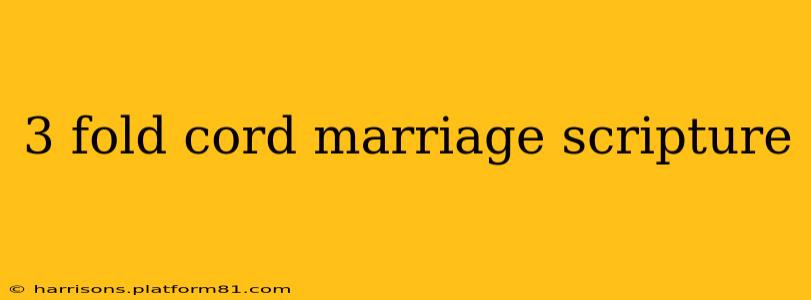The phrase "threefold cord" is often associated with marriage, drawing from Ecclesiastes 4:12: "Though one may be overpowered, two can defend themselves. A cord of three strands is not quickly broken." While the verse doesn't explicitly refer to marriage, its imagery of strength and resilience through unity resonates deeply with the marital bond, leading to its widespread application in this context. This exploration delves into the biblical understanding of marriage and examines how the "threefold cord" metaphor can enrich our comprehension of its enduring strength.
What does the Bible say about marriage?
The Bible presents a rich tapestry of perspectives on marriage, highlighting its significance as a divinely ordained institution. Genesis 2:24 describes marriage as a sacred union, where a man leaves his family to cleave to his wife, becoming one flesh. This depicts a profound oneness, signifying a deep commitment that transcends individual desires. Throughout scripture, marriage is portrayed as a reflection of Christ's relationship with the church (Ephesians 5:22-33), emphasizing love, sacrifice, and mutual submission. This framework provides a profound understanding of marriage's purpose extending beyond mere companionship.
What are the three strands of the threefold cord in marriage?
While Ecclesiastes 4:12 doesn't directly define the "three strands," applying its imagery to marriage suggests several interpretations. These strands, woven together, create an unbreakable bond:
1. God's Covenant: This forms the foundational strand. A marriage rooted in faith acknowledges God as the ultimate source of its strength and stability. Prayer, shared spiritual practices, and a commitment to living according to God's word strengthen this vital connection, providing guidance and resilience during challenging times. This isn't about religious coercion but about shared values and a mutual reliance on a higher power.
2. Husband and Wife: This represents the mutual commitment and love between the partners. This involves open communication, mutual respect, understanding, and a willingness to support each other through life's joys and sorrows. It's the active participation of both individuals in building a strong, loving relationship. The quality of this strand heavily influences the overall strength of the cord.
3. Mutual Commitment: This is the intentional choice to remain together, "for better or for worse," as traditionally stated in wedding vows. This commitment involves perseverance through difficulties, forgiveness, and a dedication to nurturing the relationship. It requires actively working at the marriage, prioritizing its needs and addressing conflicts constructively. This active participation strengthens the bonds over time, building resilience against life's challenges.
How can a couple strengthen the threefold cord in their marriage?
Strengthening the threefold cord requires consistent effort and a commitment to nurturing each strand. Here are some ways a couple can do so:
Prioritizing Spiritual Growth Together
Regular prayer, Bible study, and church attendance strengthen the foundation of their relationship with God, which underpins their marriage.
Cultivating Open Communication
Open and honest communication fosters mutual understanding and trust, helping both partners feel heard and valued.
Demonstrating Unwavering Commitment
Making conscious decisions to support each other through challenges, prioritizing the relationship, and seeking professional help when needed demonstrate a strong commitment.
Practicing Forgiveness and Grace
Acknowledging imperfections, forgiving mistakes, and offering grace builds resilience and strengthens the bond.
Is the threefold cord concept applicable to all types of relationships?
While the "threefold cord" metaphor powerfully resonates with marriage, its principle of unity and strength can also apply to other relationships. Strong family bonds, close friendships, and even business partnerships can benefit from the same principles of mutual commitment, shared values, and a unifying force that provides stability and resilience. The core principle is the power of unity.
Conclusion
The threefold cord metaphor offers a powerful image for understanding the strength and resilience of a successful marriage. By focusing on God's covenant, the commitment between husband and wife, and their mutual dedication to the relationship, couples can build a strong, enduring bond capable of withstanding life's storms. It is a beautiful image that speaks to the enduring strength found in unity and commitment.
